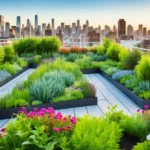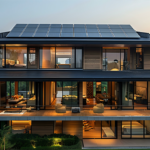Blending Structures with Nature
- By -Peter
- Posted on
- Posted in Modern Architecture
Blending structures with nature in architecture involves creating designs that complement and enhance the natural environment. This approach not only fosters aesthetic harmony but also promotes sustainability and a deeper connection to the surroundings.

Principles of Harmonious Design
Achieving harmony between architecture and nature requires principles such as respecting natural forms, using sustainable materials, and incorporating natural elements like light and vegetation into the design.
Respect for Natural Forms
Architects often draw inspiration from natural forms such as the curves of hills or the patterns of trees. By mirroring these shapes in their designs, they create structures that appear organic and blend seamlessly with the landscape.
Sustainable Materials and Practices
Using sustainable materials like recycled wood, bamboo, or locally sourced stone minimizes environmental impact. Sustainable practices such as energy-efficient design and water management systems further integrate buildings into their natural contexts.
Integration of Natural Elements
Incorporating natural elements such as green roofs, living walls, and large windows that frame scenic views not only enhances aesthetic appeal but also connects occupants with the natural world, promoting well-being.
Examples of Architectural Harmony
Examples like the Fallingwater house by Frank Lloyd Wright demonstrate how architecture can harmoniously coexist with nature, utilizing cantilevered designs that integrate with the waterfall and forest landscape.
Biophilic Design Approach
Biophilic design goes beyond mere aesthetics to incorporate natural materials, light, views, and patterns that evoke a sense of nature. This approach enhances human well-being by fostering a connection to the natural environment.
Cultural and Historical Contexts
Incorporating local cultural and historical contexts ensures that architectural designs resonate with the community and landscape. This approach respects traditions while celebrating the natural beauty of the region.
Challenges in Blending Structures with Nature
Challenges include balancing architectural innovation with environmental preservation, addressing climate change impacts, and navigating regulatory frameworks that protect natural habitats.
Benefits of Harmonious Design
Harmonious architecture enhances property value, promotes sustainable development, and creates spaces that support health and well-being. It also fosters a sense of place and cultural identity within communities.
Urban Context and Green Spaces
In urban settings, integrating green spaces, rooftop gardens, and vertical forests helps mitigate the urban heat island effect, improve air quality, and provide residents with natural retreats amid dense cityscapes.
Educational and Recreational Spaces
Schools, museums, and recreational facilities can benefit from designs that blend seamlessly with natural surroundings, creating inspiring environments conducive to learning, creativity, and relaxation.
Future Directions in Architecture
Future trends include advancements in green building technologies, innovative use of sustainable materials, and a growing emphasis on resilient design that responds to climate change and natural disasters.
Conclusion: Achieving Sustainable Harmony
Blending structures with nature in architecture is not just about aesthetics but about creating sustainable, resilient, and culturally relevant designs that harmonize with their surroundings. By embracing principles of respect for natural forms, sustainable practices, and biophilic design, architects can create spaces that enhance both human well-being and environmental stewardship.
Architectural designs that integrate seamlessly with nature enrich the built environment, fostering a deeper connection to the natural world while promoting ecological balance and resilience. As we continue to innovate in architecture, the pursuit of harmony with nature remains essential for creating spaces that are both functional and enriching for future generations.



